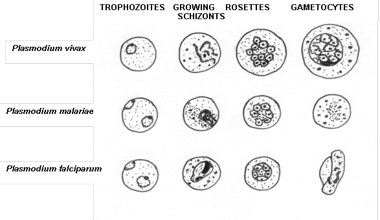The disease caused by Plasmodium is known as malarial fever. It is charcterised by recurring bouts of fever, each lasting several hours. The febrile condition in man is due to toxins liberated into the blood along with the merozoites when the corpuscle is ruptured at the end of schizogony.
There are four species of Plasmodium known to cause malaria in man. The commonest and most widely distributed species is P vivax. It causes benign tertian malaria in which the fever recurs every third day (every 48 hours).

Falciparum is largely limited to the tropics and subtropics and causes the malignant tertian or subtertian malaria. This type of malaria has a high death rate. Blood corpuscle parasitised by this species tend to clump together and block up small blood vessels and damage the essential organs. It is a dangerous species and the disease often appears in an epidemic scale.
P malariae causes quartan malaria with feverish fits every fourth day (every 72 hours). The fourth species is P. ovale. It is principally found in west Africa but occassionally in S. America, Russia and Palestine. It causes benign tertian malaria in which the fever recurs every third day (every 48 hours).
These four species differ from each other in the details of structure, time needed to complete the schiogzony, the incubation period, number of merozoites released and duration of sexual cycle.













